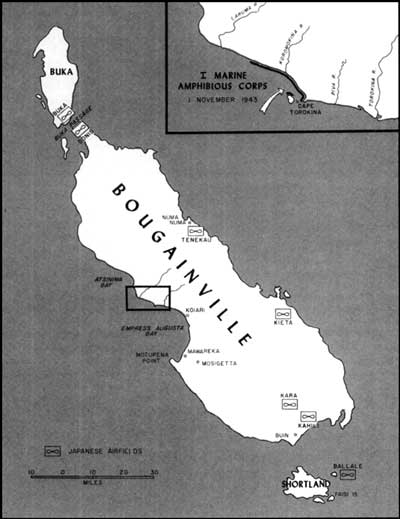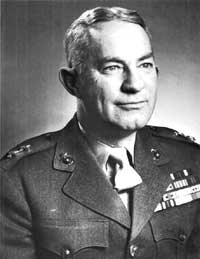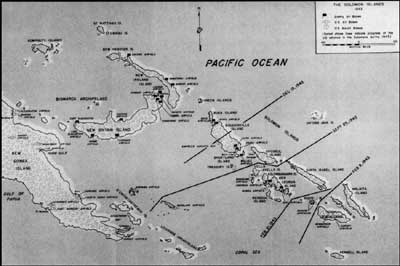| Marines in World War II Commemorative Series |
|
TOP OF THE LADDER: Marine Operations in the Northern Solomons by Captain John C. Chapin, USMCR (Ret) Assault landings began for the men in the blackness of the early hours of the morning. On 1 November 1943, the troops of the 3d Marine Division were awakened before 0400, went to General Quarters at 0500, ate a tense breakfast, and then stood by for the decisive command, "Land the Landing Force." All around them the preinvasion bombardment thundered, as the accompanying destroyers poured their 5-inch shells into the target areas, and spotters in aircraft helped to adjust the fire. As the sun rose on a bright, clear day, the word came at 0710 for the first LCVPs (Landing Craft, Vehicle and Personnel) to pull away from their transport ships and head for the shore, a 5,000-yard run across Empress Augusta Bay to the beaches of an island called Bougainville. Almost 7,500 Marines were entering their LCVPs (with Coast Guard crew and coxswains) for an assault on 12 color-coded beaches. Eleven of these extended west from Cape Torokina for 8,000 yards to the Koromokina Lagoon. The 12th was on Puruata Island just offshore from the beaches. The six beaches on the right were assigned to Colonel George W. McHenry's 3d Marines and Lieutenant Colonel Alan Shapley's 2d Raider Regiment (less one battalion). The five on the left and Puruata Island were the objectives of Colonel Edward A. Craig's 9th Marines and Lieutenant Colonel Fred D. Bean's 3d Raider Battalion.
As the men headed for shore, 31 Marine torpedo and scout bombers, covered by fighters, came screaming in from their base at Munda, bombing and strafing to give the beaches a final plastering. At 0726, the first wave touched ground, four minutes ahead of the official H-Hour. As the other waves came in, it was immediately apparent that there was serious trouble in two ways. A high surf was tossing the LCVPs and LCMs (Landing Craft, Medium) around, and they were landing on the wrong beaches, broaching, and smashing into each other in the big waves. By the middle of the morning, 64 LCVPs and 22 LCMs were hulks littering the beaches. Three of the designated beaches had to be abandoned as unusable.
Major Donald M. Schmuck, commanding a company in the 3d Marines, later recalled how, in the "mad confusion" of the beach head, his company was landed in the midst of heavy gunfire in the middle of another battalion's zone on the beach of Torokina. Running his company on the double through the other battalion and the 2d Raiders' zone across inlets and swamp, Major Schmuck got his men to the right flank of his own battalion where they were to have landed originally. His surprised battalion commander, Lieutenant Colonel Hector de Zayas, stared at the bedraggled new arrivals exclaiming, "Where have you been?" Major Schmuck pointed back to Cape Torokina and replied, "Ask the Navy!"
The other trouble came from the Japanese defenders. While the 9th Marines on the left landed unopposed, the 3d Marines on the right met fierce opposition, a deadly crossfire of machine gun and artillery fire. One Japanese 75mm gun, sited on Cape Torokina, was sending heavy enfilade fire against the incoming landing waves. It smashed 14 boats and caused many casualties. The boat group commander's craft took a direct hit, causing the following boat waves to become disorganized and confused. Machine gun and rifle fire, with 90mm mortar bursts added, covered the shoreline. Companies landed in the wrong places. Dense underbrush, coming right down to the beaches, shrouded the defenders in their 25 bunkers and numerous rifle pits. The commanding officer of the 1st Battalion, 3d Marines, Major Leonard M. "Spike" Mason, was wounded and had to be evacuated, but not before he shouted to his men, "Get the hell in there and fight!" Nearby, the executive officer of the 2d Raider Regiment, Lieutenant Colonel Joseph J. McCaffery, was directing an assault when he was severely wounded. He died that night.
In spite of the chaos, the intensive training of the Marines took hold. Individuals and small groups moved in to assault the enemy, reducing bunker after bunker, dropping grenades down their ventilators. For an hour, the situation was in doubt. The fierce combat led to a wry comment by one captain, Henry Applington II, comparing "steak and eggs served on white table cloths by stewards . . . and three and a half hours and a short boat ride later . . . rolling in a ditch trying to kill another human being with a knife." The devastating fire from the 75mm cannon on Cape Torokina was finally silenced when Sergeant Robert A. Owens, crept up to its bunker, and although wounded, charged in and killed the gun crew and the occupants of the bunker before he himself was killed. A posthumous Medal of Honor was awarded to him for this heroic action which was so crucial to the landing. Meanwhile, on Puruata Island, just offshore of the landing beaches, the noise was intense; a well-dug-in contingent of Japanese offered stiff resistance to a reinforced company of the 3d Battalion, 2d Raiders. It was midafternoon of D plus one before the defenders in pill boxes, rifle pits, and trees were subdued, and then some of them got away to fight another day. A two-pronged sweep and mop-up by the raiders on D plus 2 found 29 enemy dead of the 70 Japanese estimated to have been on that little island. The raiders lost five killed and 32 wounded. An hour after the landings on the main beaches a traditional Marine signal was flashed from shore to the command and staff still afloat, "Situation well in hand." This achievement of the riflemen came in spite of the ineffective prelanding fire of the destroyers. The men in front-line combat found that none of the 25 enemy bunkers on the right-hand beaches had been hit. Some of the naval bombardment had begun at a range of over seven miles, and the official Marine history summarized, "The gunfire plan . . . had accomplished nothing."
Unloading supplies and getting them in usable order on the chaotic beaches was a major problem. Seabees, sailors, and Marines all turned to the task, with 40 percent of the entire landing force laboring as the shore party. They sweated 6,500 tons of supplies ashore.
Simultaneously, the batteries of the 12th Marines were struggling to get their artillery pieces ashore and set to fire. One battery, in support of the 2d Raider Battalion, waded through a lagoon to find firing positions. Amtracs (amphibian tractors), supplemented by rubber boats, were used to ferry the men and ammunition to the beaches. The 90mm antiaircraft guns of the 3d Defense Battalion were also brought ashore early to defend against the anticipated air attacks. The Japanese had been quick to respond to this concentration of American ships. Before the first assault boats had hit the beach, a large flight of enemy carrier planes was on its way to attack the Marines and their supporting ships. New Zealand and Marine fighters met them in the air and the covering destroyers put up a hail of antiaircraft fire, while the transports and cargo ships took evasive action. Successive Japanese flights were beaten off; 26 enemy planes were shot down. Major General Allen H. Turnage, USMC
Allen Hal Turnage was born in Farmville, North Carolina, on 3 January 1891. After attending Horner Military Academy and then the University of North Carolina, at age 22 he was appointed a second lieutenant in the U.S. Marine Corps. Sent to Haiti, he served with the 2d Marine Regiment from 1915 to 1918, becoming a company commander in the Haitian Gendarmerie. A captain in 1917, Turnage did get to France where he commanded the 5th Marine Brigade Machine Gun Battalion. Home in 1919, he was assigned to the 5th Marines at Quantico and became regimental adjutant and an instructor for the first Field Officers School, 1920-22. A major in 1927, Turnage had three years with the Pacific fleet, and then he served with the U.S. Electoral Mission in Nicaragua (1932). He came back to Washington, made lieutenant colonel in 1934 and full colonel in 1939. He was director of the Basic School at the Philadelphia Navy Yard, and, in the spring of 1939, he was sent to China to head Marine forces in North China. In summer of 1941, on the eve of the Japanese attack on Pearl Harbor, he returned to Headquarters in Washington. In 1942, as a brigadier general, he commanded the burgeoning Marine Base and Training Center at New River, North Carolina. When the 3d Marine Division was formed in September 1942, he was named assistant division commander. In the summer of 1943 Turnage was promoted to major general and selected to head the division. He then led the division on Bougainville and in the liberation of Guam, the first American territory to be recaptured from the enemy. After the war, he was appointed Assistant Commandant, followed by promotion to lieutenant general and command of FMFPac (Fleet Marine Force, Pacific). He retired 1 January 1948, and died 22 October 1971. His awards included the Navy Cross, the Navy Distinguished Service Medal, and the Presidential Unit Citation (which his men received for both Guam and Iwo Jima). The men in the rifle battalions long remembered the sight. On one occasion, a Marine Corsair was about to pull the trigger on an enemy Zeke ("Zero") fighter set up perfectly in the pilot's sights when a burst of fire from Marine .50-caliber machine guns on the beach, meant for the Zeke, shot the American down. One of the riflemen later recalled that the Marine pilot fell into the ocean and surfaced with a broken leg. "We waded out to get him. He was ticked off — mostly because he missed the Jap."
In spite of all these problems, the assault battalions had, by the end of D-Day, reached their objectives on the Initial Beachhead Line, 600 — 1,000 yards inland. One enormous unexpected obstacle, however, had now became painfully clear. Available maps were nearly useless, and a large, almost impenetrable swamp, with water three to six feet deep, lay right behind the beaches and made movement inland and lateral contact among the Marine units impossible. The night of D-Day was typical for the ground troops. By 1800, darkness had set in and the men all knew the iron-clad rule: be in your foxhole and stay there. Anyone moving around out there was a Japanese soldier trying to infiltrate. John A. Monks, Jr., quoted a Marine in his book, A Ribbon and a Star:
At sea, the transports and cargo ships were withdrawn; there was intelligence that enemy naval forces were on the move.
|











